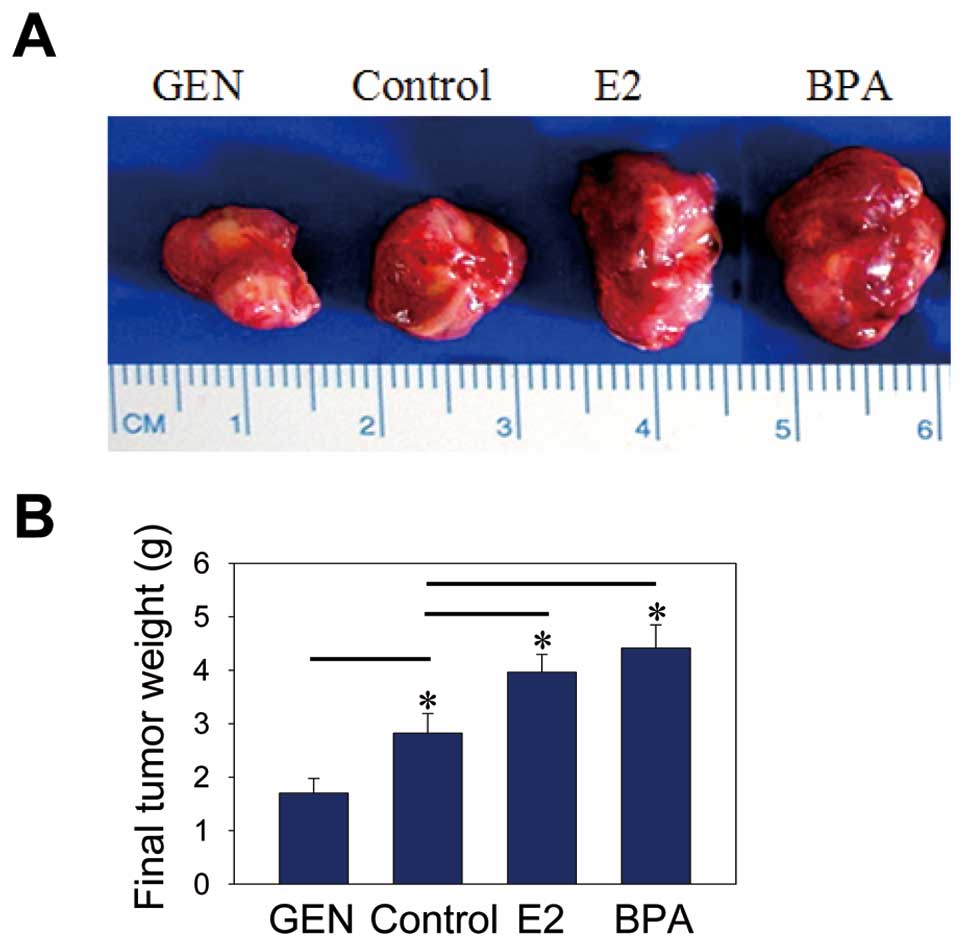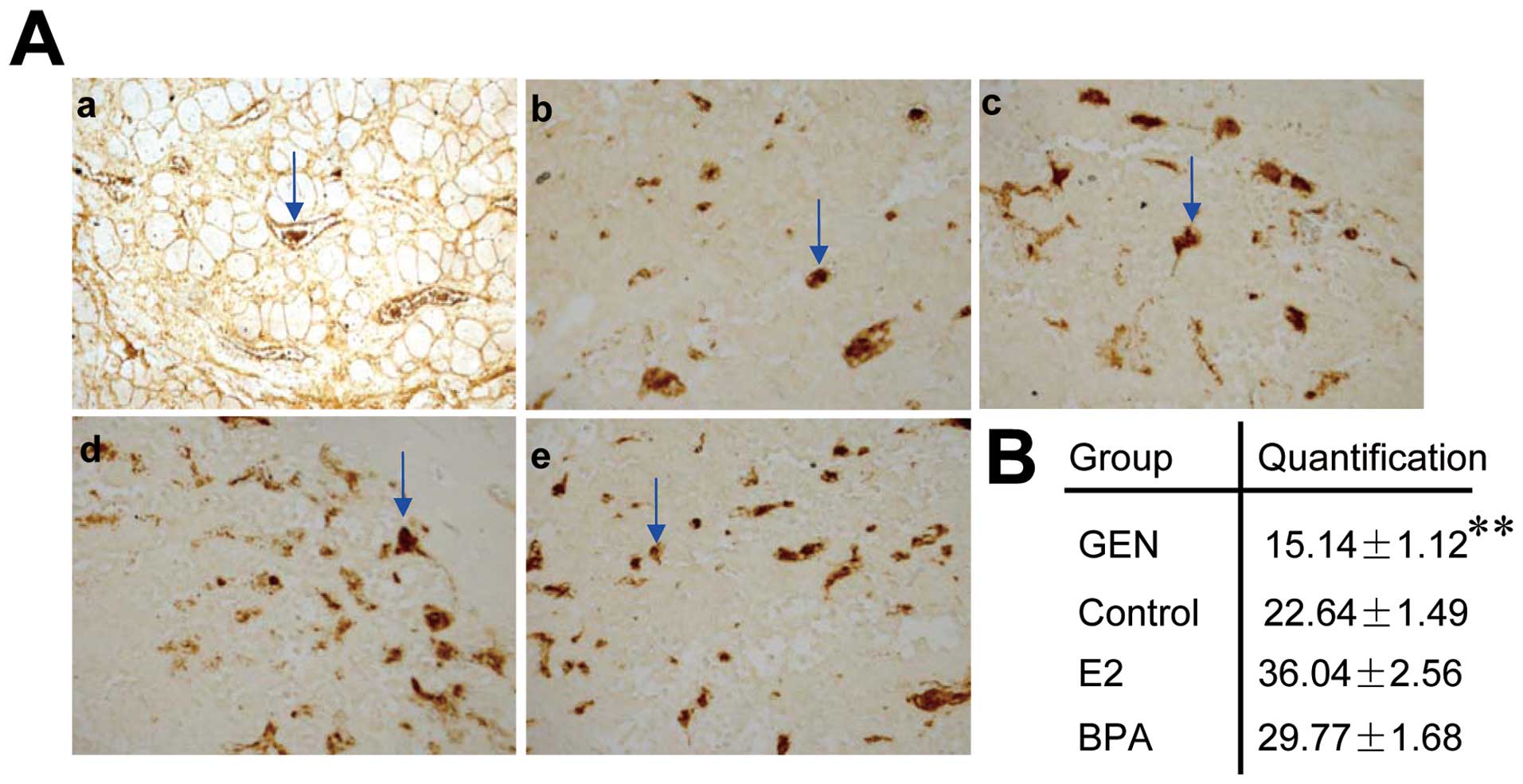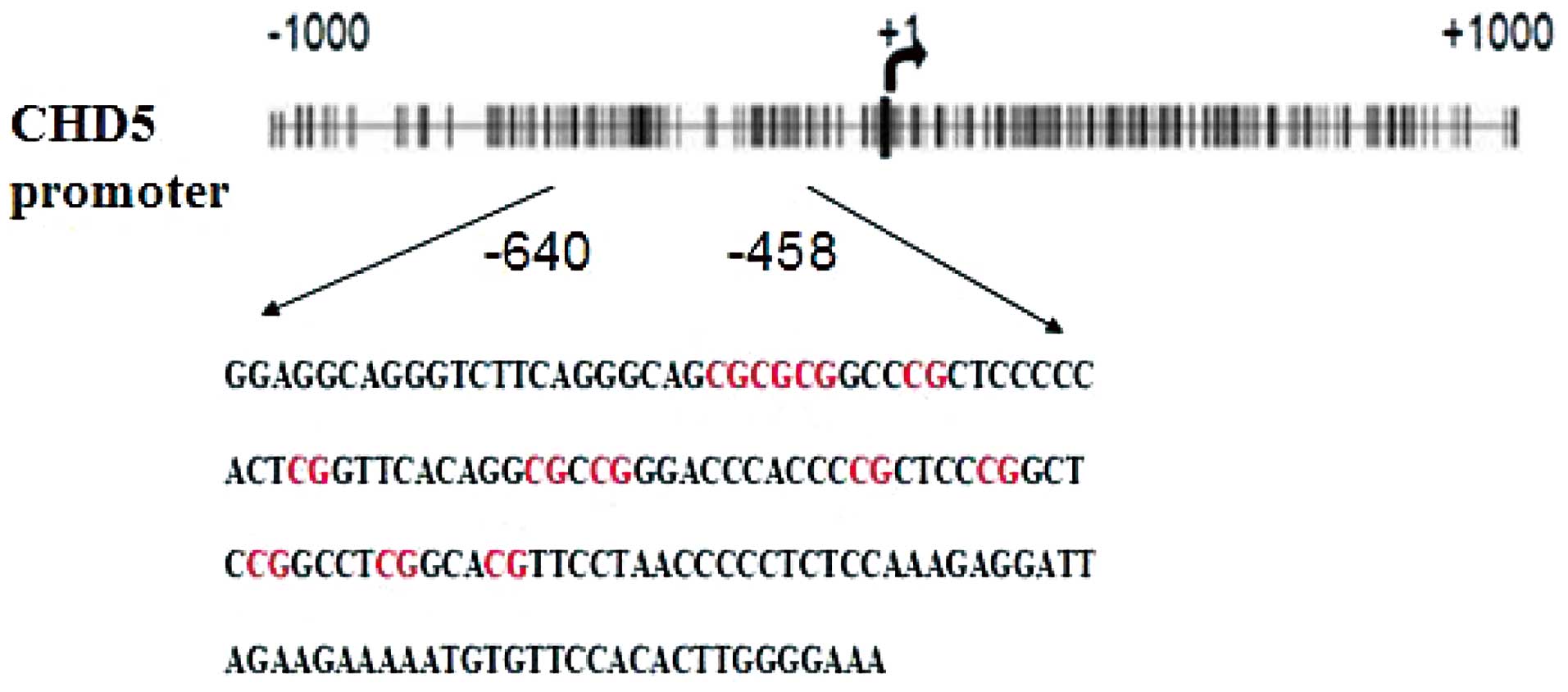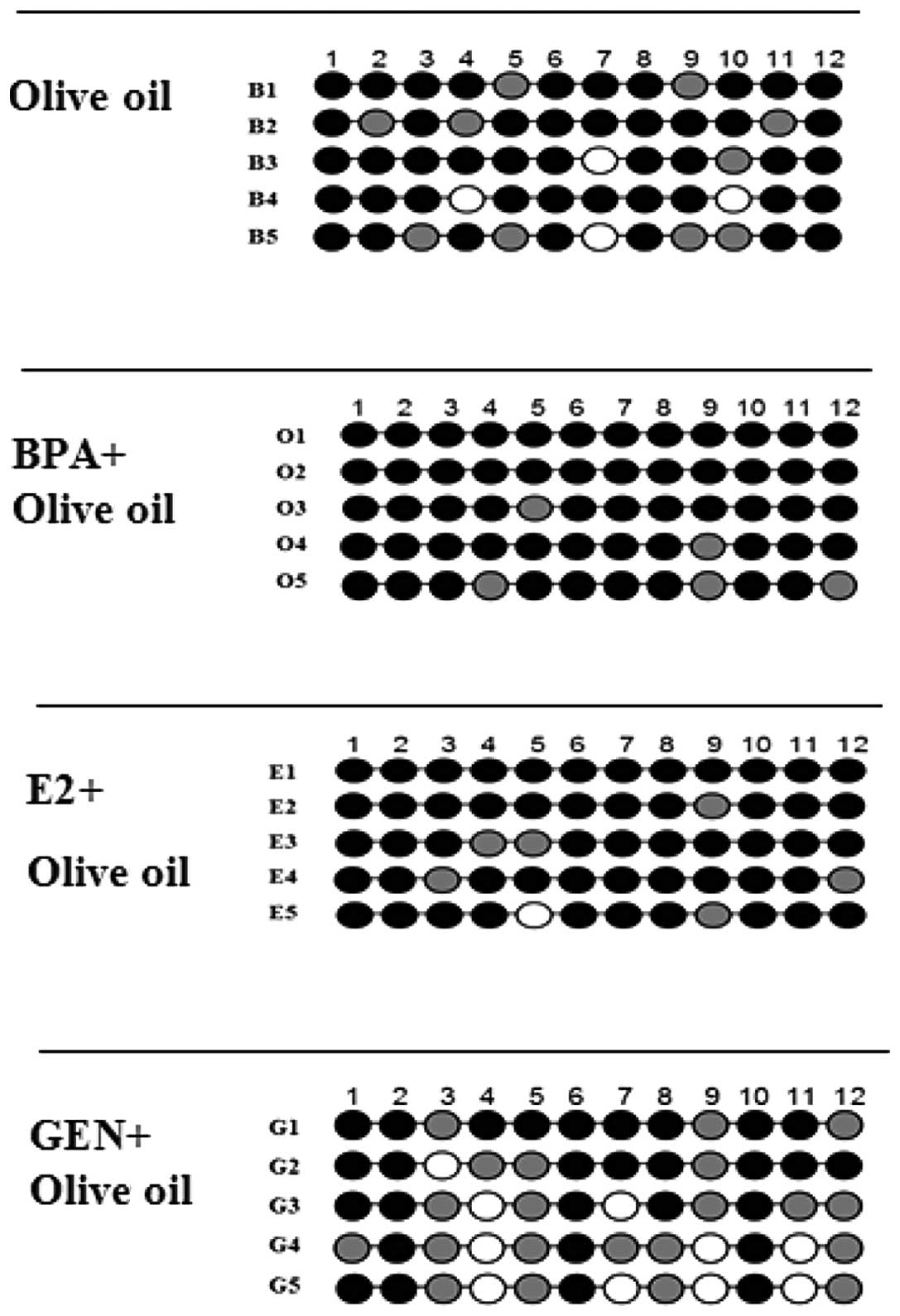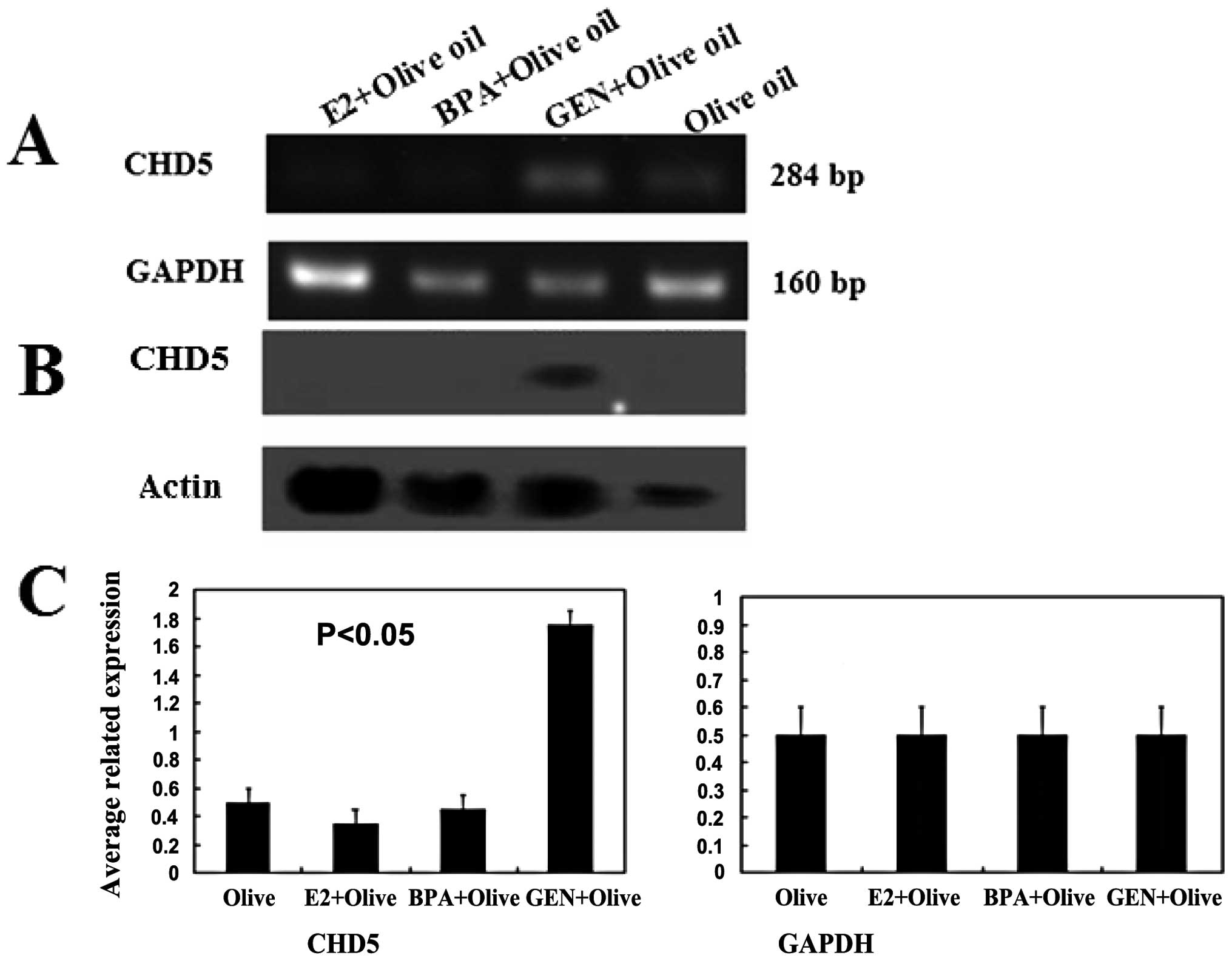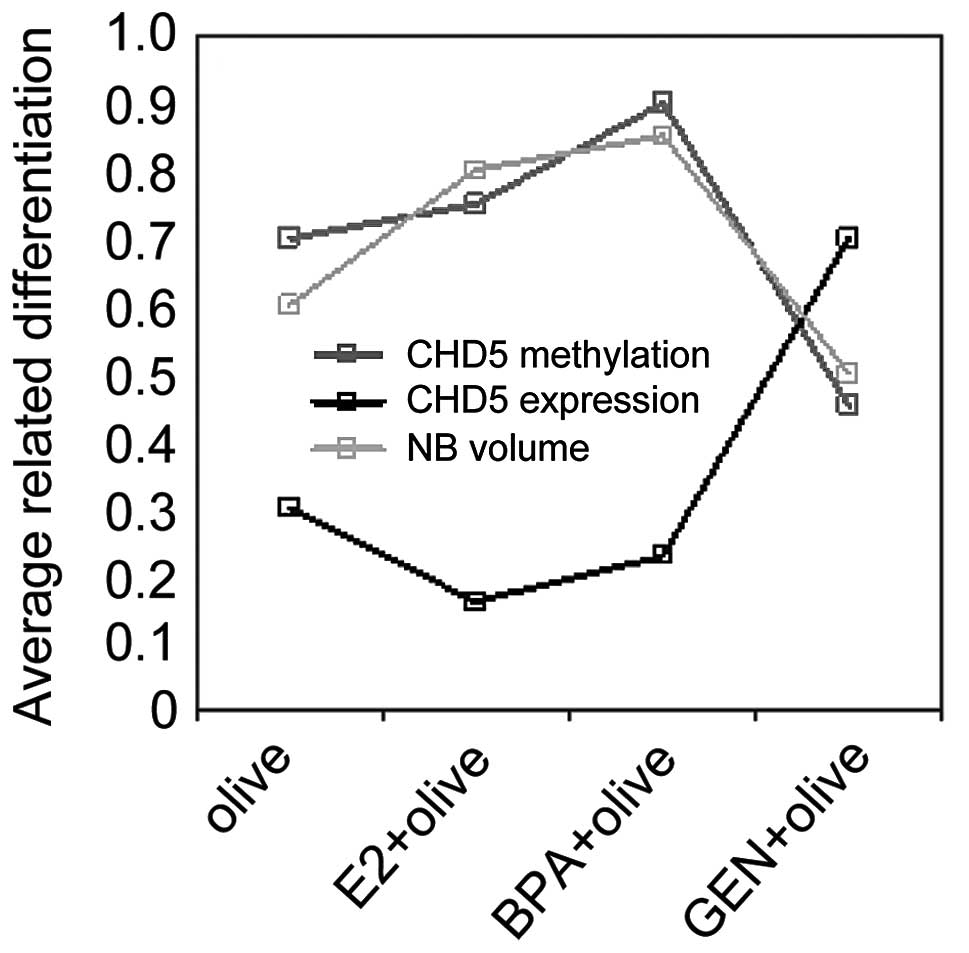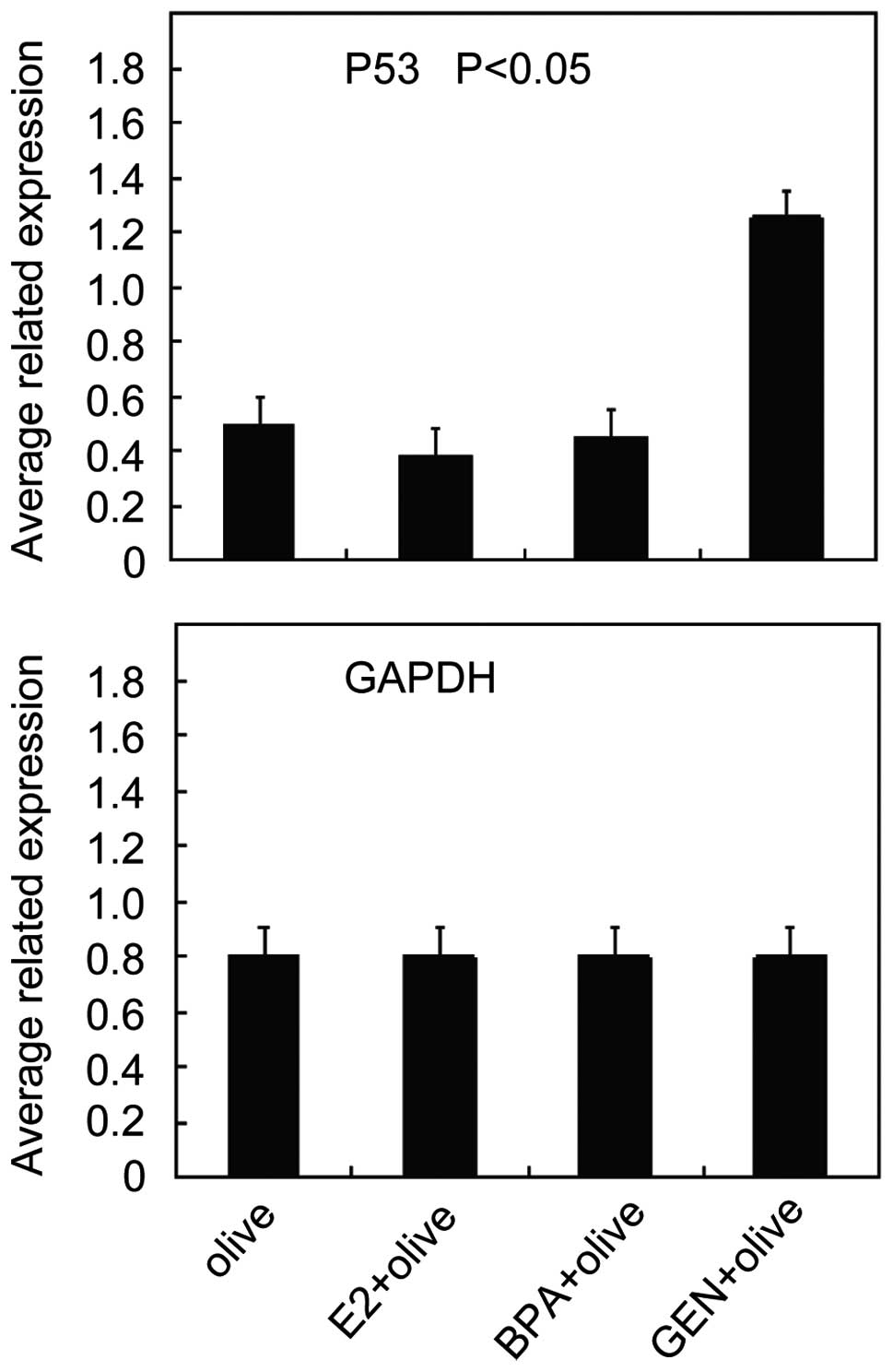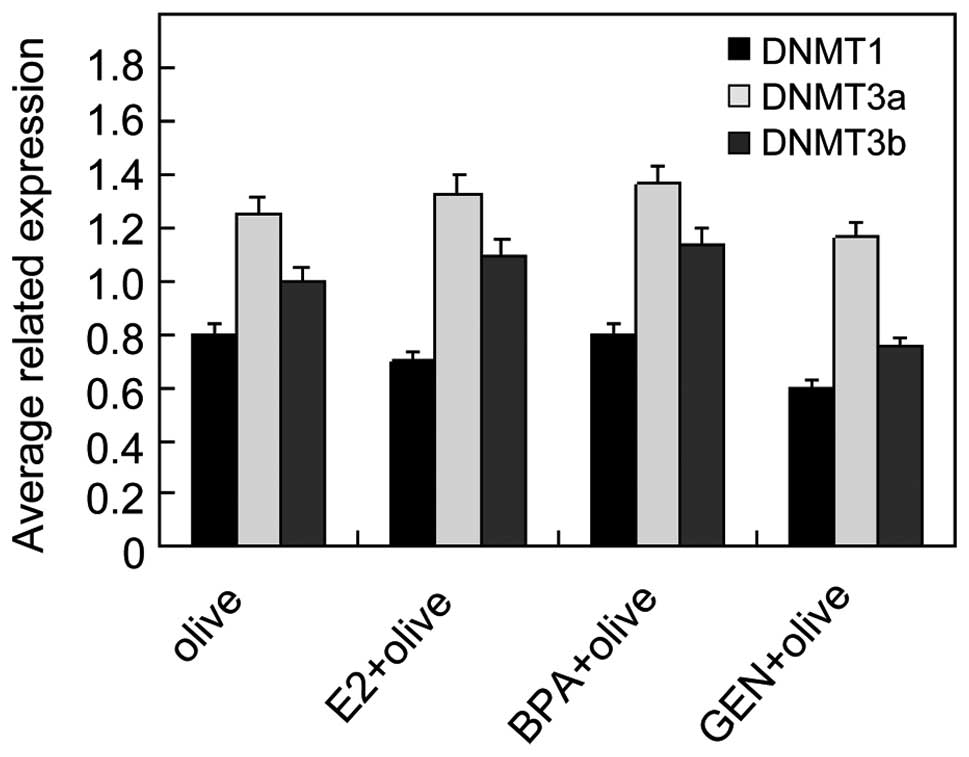Genistein demethylates the promoter of CHD5 and inhibits neuroblastoma growth in vivo
- Authors:
- Published online on: September 6, 2012 https://doi.org/10.3892/ijmm.2012.1118
- Pages: 1081-1086
Abstract
Introduction
Neuroblastoma is a childhood tumor derived from the nervous system. Tumorigenesis of NB is a complicated process. In NB tumor, the changes on chromosome remodeling have been found, including gaining of chromosome 17q and losses of 1p, 3p and 11q, histone methylation and acetylation of H3K9 (1). The alteration at molecular level includes high expression of oncogene MYCN and ALK, silence of tumor suppressor genes RAS-association domain family 1 isoform A (RASSF1A) and SF1, and silence of apoptosis related gene caspase-8 (2). DNA methylation regulation largely contributes to the abnormal expression of these genes. Especially, hypermethylation at TSG promoter is observed during tumorigenesis. Decades of investigation on DNA methylation of NB found that epigenetic silence of caspase-8 and RASSF1A, among the 75 selected methylated candidate genes, were responsible for the development and progress of the disease (2).
Dietary soy has been regarded as a healthy food for reducing heart disease and cancer risk. The epigenetic changes with dietary soy in cynomolgus monkey have been verified (3). Some flavonoid compositions, including genistein, may transmit these epigenetic changes to the next generation. Genistein, as one of the soy-derived bioactive isoflavones, affects tumorigenesis through epigenetic regulations (4). The major process of DNA methylaton is that methyl is transferred from SAM to cytosine by DNMT (5). Genistein may work as a DNMT inhibitor that can regulate gene expression by erasing DNA methylation at the promoter. Genistein has been proved to promote DNA demethylation of SF1 promoter in endometrial stromal cells (6), and has the capacity of preventing cancer risk of breast cancer (5). There are no significant changes in embryo stem cells treated with genistein, but for a set of genes, regulation after de novo DNA methyaltion in the early embryo may be sensitive to genistein (7), and the next generation can inherit this pattern of DNA methylation alteration. In genistein-mediated differentially methylated regions (DMRs), 95 of 149 DMRs are less methylated in promoters (7). Overall, genistein alters the configuration of chromatin, and acts as a DNMT inhibitor, demethylating the hypermethylated regions at TSG promoters, such as p16 (8–11).
The tumor suppressor factor CHD5 was uncovered (12), and it has been verified that the defect of CHD5 leads to excessive proliferation of tissues and induces tumorigenesis. CHD5 acts under the downstream pathway of p53 and is recognized as a TSG. Fujita et al proved that low expression level of CHD5 also exists in NB (13), which prompted us to examine the role of CHD5 in NB and our results indicate that CHD5 was associated with malignancy grade of NB and may be regulated by genistein under an epigenetic pathway.
Materials and methods
Neuroblastoma cell culture
Human neuroblastoma SK-N-SH cells were purchased from the Cell Bank of the Chinese Institute of Biochemistry and Cell Biology (Shanghai, China). For routine maintenance, the neuroblastoma cell line was cultured in MEM supplemented with 0.1 M L-glutamine, 10% (v/v) FBS, 100 U/ml of penicillin, 100 U/ml of streptomycin, and 100 U/ml of kanamycin at 37°C with 5% (v/v) CO2 in a humidified incubator. For the assessment of estrogen-like activity, the cells were cultured in phenol-red free MEM supplemented with 10% (v/v) FBS, which was pretreated with sulphatase and dextran-coated charcoal (CD-FBS) (14).
Nude mice subcutaneous injection and diet
BALA/C nude mice, ∼4 weeks of age on arrival, were purchased from Shanghai Slaccas Co., and maintained in micro-isolator cages under pathogen-free conditions on a 12-h light/12-h dark schedule for a week. All animal experiments were approved by the Institutional Animal Use and Care Committee of Shanghai Jiao Tong University. After housing for a week, the mice were inoculated with 3×106 SK-N-SH NB cells in 0.1 ml of PBS. After injection, the mice were randomly divided into four groups and treated with 2 mg genistein (Sigma), 2 mg BPA and E2 as control and olive oil as blank control everyday. After 15 days, mice were sacrificed, and tumors were excised, weighed, fixed in 10% (v/v) buffered formalin and processed for histology analysis.
Immunohistochemistry and microvessel density (MVD)
According to the protocol of Zhao et al (15), the primary antibody of factor VIII-related antigen (polyclonal, ZA-0111 Santa Cruz) was used. The stained sections were screened at magnification x200 under a light microscope to identify the five random regions of the section. Vessels were counted and the average numbers of microvessels were recorded by two observers, and the mean value was used for analysis.
Analysis of CpG methylation by bisulfite sequencing
DNA extraction from NB transplantable tumors was treated with DNA samples bisulfite treatment provided by EZ DNA Methylation-Gold kit (Cat: D5005). Reaction conditions: 98°C for 10 min, 64°C for 2.5 h, stored at 4°C for <20 h. Primers were designed by methylation analysis software MethPrimer. CHD5M-F: GGGGTATTATTTGGATTTTTTTTG; CHD5M-R: CTAATTACTATAACAACCCCATCCC. PCR amplification: We used fidelity Taq enzyme (1X Platinum PCR MasterMix, Invitrogen), 50 μl reaction system containing 45 μl Platinum PCR MasterMix, 1.5 μl sense primer, 1.5 μl anti-sense primer, 2 μl bisulfite treated DNA. Reaction conditions: 95°C for 3 min, first cycle: 95°C for 30 sec, 58°C for 30 sec, 72°C for 40 sec, running 8 cycles as touchdown 1°C of annealing temperature at each cycle, and then 95°C for 30 sec, 50°C for 30 sec, 72°C for 40 sec, running 40 cycles.
Transformation and cloning
PCR products purified with universal DNA Purification kit (Tiangen) were ligated into PMD-18T vector (Takara), at the concentration ratio of 1:3 (PCR products:PMD-18T). The recombinant T vector was transformed into E. coli. DH5α, and then cultured on LB solid medium containing ampicillin (1:1000 diluted), 40 μl X-gal and 8 μl IPTG overnight. Ten clones for each PCR product were picked up to be cultured in liquate LB medium for 6 h.
Real-time reverse transcription polymerase chain reaction (real-time RT-PCR)
Total RNA was isolated using a homogenizer and TRIzol™ reagent (Invitrogen) according to the manufacturer’s instructions. The primers sequences are described in Table I. PCR reaction system: 2X PCR master mix (Tiangen), conditions: 95°C for 3 min, 95°C for 30 sec, 50°C for 30 sec, 72°C for 40 sec, 35 cycles, then 72°C for 10 min, storing at 4°C. For real-time PCR, ABI 7900 real-time PCR machine was used. Conditions: Step 1, 95°C for 30 sec; Step 2, 95°C for 5 sec, 60°C for 40 sec, 40 cycles.
Western blotting
Protein were separated by 12% SDS-PAGE and then transferred to polyvinylidene fluoride (PVDF, Sigma) membrane using electronic transfer method. Primary rabbit anti-CHD5 polyclonal antiserum (1:200, Abcam, Cambridge, UK) was applied for hybridization at 4°C overnight. Then the secondary hybridization was performed using peroxidaseconjugated goat anti-mouse IgG (1:4000 diluted) at 37°C for another 1 h. Protein bands were then developed with enhanced chemiluminescence (ECL) detection reagents (Amersham Biosciences, Piscataway, NJ).
Statistical analysis
All statistical analyses were performed using the SPSS17.0 software. The results are presented as mean ± standard deviation (SD). Differences among the groups were assessed by analysis of variance (ANOVA). P<0.05 was considered statistically significant.
Results
Genistein inhibited the NB cells growth in vivo
The genistein treatment resulted in smaller tumor size (Fig. 1A) and significantly inhibited NB growth (Fig. 1B) compared to the other three treatments in nude mice. Besides, the MVD in genistein-treated mice decreased compared with that of other three groups (Fig. 2, P<0.01). These results suggested that genistein had antitumor effects.
Genistein demethylated the promoter of CHD5
A CpG island near tandem repeats sequence (TRS) containing 152-nt sequences and 12 CpG dinucleotides, as highlighted in red in Fig. 3 was selected for methylation analysis. DNA was extracted from NB and then treated with EZ DNA Methylation-Gold kit and the PCR amplification was performed with CHD5 primer pairs. Ten clones were selected for each PCR product. CpG dinucleotides were indicated as ellipses (Fig. 4): black, fully methylated (>60%); gray, partially methylated (40–60%) and white, unmethylated (<40%). The results showed that the methylation level at promoter of CHD5 was reduced by genistein treatment (<60%), and almost no significant changes were found in BPA and E2 group (>80%) compared with control group suggesting that tumor suppressor gene CHD5 may be epigenetically regulated by genistein.
Effect of genistein on CHD5 expression
The expression of CHD5 at mRNA level was increased in genistein treatment group compared with that of control groups, while BPA, E2 treatments displayed weak expression of CHD5 (Fig. 5A and C). Only the expression of CHD5 protein in genistein-treated group was obviously observed (Fig. 5B). The expression level of CHD5 was associated with the changes of the methylation level at CHD5 promoter. These results showed that the level of CHD5 can be regained by genistein.
Effect of demethylation of CHD5 by genistein on NB proliferation
CHD5 methylation not only influences its expression level but also determines the NB growth in vivo. As shown in Fig. 6, genistein increased the protein expression level of CHD5 via reducing its gene methylation level, thereby inhibiting NB growth in vivo. These results suggested that epigenetic regulation of CHD5 plays a vital role in NB proliferation.
Effect of genistein on P53 expression
P53 is widely recognized as a tumor suppressor gene, which inhibits tumor growth and induces cell apoptosis. However, it is also a control target of CHD5. Our results showed that the expression of P53 was increased after genistein treatment (Fig. 7).
Effect of genistein on DNMT isoforms expression
The expression of DNMT3b decreased significantly in genistein treatment group, while no obvious changes were observed in the isoforms DNMT1 and DNMT3a, as shown in Fig. 8, suggesting that genistein acts as a DNMT inhibitor and involves epigenetic modifications. The reduction of DNMT3b implies that DNMT3b may be implicated in DNA demethylation in tumorigenesis of NB.
Discussion
The environmental estrogen-like contaminants that are collectively called environmental endocrine disruptors (EEDs), xenoestrogens, or environmental estrogens, are derived from a variety of relatively common and abundant sources, such as pesticides, plastics, combustion by-products, plants and agricultural products (16–20). These contaminants can enter the body by ingestion, adsorption or inhalation. They bind to the estrogen receptor (ER), mimic or interfere with the action of natural estrogens in animals and humans (21,22). Bisphenol A (BPA), a monomer component of polycarbonate plastics and epoxy resins, is widely used in many consumer products. It has been verified that BPA can promote the proliferation of SK-N-SH cells, and the estrogen receptor pathway may be involved in this effect (23). How to resist the hurt of estrogen-like contaminants? Soy products were found to play a critical role in reducing cardiovascular disease and carcinogenesis and increasing evidence showed that soy phytoestrogens are at least partially responsible for this effect (24–26). The causal relationship and the mechanisms of phytoestrogen action have yet to be determined (27). Genistein, one of the many phytoestrogens contained in soy, has been shown to inhibit the proliferation of both breast and prostate cancer cells (28).
In this study, we explored the effect of genistein on NB cell growth in vivo. We established nude mice model by subcutaneous injection of SK-N-SH cells, then performed oral ingestion with BPA, E2, and genistein, respectively, since SK-N-SH tumor formed in these nude mice. Compared with E2 and BPA group, in the genistein group, tumors shrank. Hemangiogenesis and lymphangiogenesis are associated with progressed tumor stages, in GEN group, however, the microvessel density (MVD) also reduced, suggesting that the tumor grade of the malignancy was reduced, indicating that genistein had anti-cancer ability against NB.
We aimed to explore the mechanisms of genistein remitting the process of NB. NB is a childhood cancer that is characterized as having genomic deletions at chromosome 1p. Tumor suppressor CHD5 localize in this region and it has been reported that the CHD5 expression was low in NB, and partially because the CHD5 promoter was highly methylated (13). Okawa et al (29) found that CHD5 had virtually absent expression in 30 NB cell lines, and Fujita et al (13) verified CHD5 was a tumor suppressor gene against NB, and its expression may be inhibited by promoter methylation. In our study, CHD5 promoter in E2 and BPA group was highly methylated, and almost all 12 CpG sites were methylated in BPA group, which is consistent with Fujita et al (13). However, genistein reverses the process, demethylation of CDH5 gene was found in genistein group, enhancing the mRNA and protein levels of CHD5, exhibiting its antitumor effect synergistically with p53. The degree of p53 expression had positive correlation with that of CHD5 demethylation, suggesting that genistein not only influenced CHD5, but also restarted the normal function of other anti-cancer genes, such as P53. p53, a key gene associated with cancer proliferation and apoptosis, and an important suppressor of WNT signaling (30). We hypothesized that genistein can erase hypermethylation level at promoter of CHD5, and improve the expression level of CHD5 as well as p53, thereby cooperating with p53 to mediate cancer development and apoptosis possibly through the WNT signaling pathway.
DNA methylation, as a main epigenetic modifier, has been shown to be correlated to tumorigenesis (31). Interestingly, in our study, we found that genistein could regulate DNA methylation level of CHD5 which is consistent with previous studies (32,33). DNA methylation and demethylation on CpG dinucleotides are regulated by DNMT commonly regarded as a candidate of epigenetic target (34,35). Therefore, we wished to verify whether genistein regulates methylation level of CHD5 via modulating DNMT, and the results of our study showed that genistein indeed to some extent inhibited the expression of DNMTs.
In conclusion, genistein can erase the methylation of CHD5 promoter and improve the expression level of CHD5 as well as p53, thereby cooperating with p53 to inhibit NB proliferation in vivo possibly through the WNT signaling pathway. This process may be achieved by inhibiting DNMT. As a natural source from soy, genistein has a very broad prospect for future therapy of NB patients.
References
|
M BerdascoS RoperoF SetienEpigenetic inactivation of the Sotos overgrowth syndrome gene histone methyltransferase NSD1 in human neuroblastoma and gliomaProc Natl Acad Sci USA1062183021835200910.1073/pnas.090683110620018718 | |
|
A DecockM OngenaertJ VandesompeleF SpelemanNeuroblastoma epigenetics: from candidate gene approaches to genome-wide screeningsEpigenetics6962970201110.4161/epi.6.8.1651621725203 | |
|
TD HowardSM HoL ZhangEpigenetic changes with dietary soy in cynomolgus monkeysPloS One6e26791201110.1371/journal.pone.002679122046358 | |
|
Y ZhangH ChenGenistein, an epigenome modifier during cancer preventionEpigenetics6888891201110.4161/epi.6.7.1631521610327 | |
|
SI KhanP AumsuwanIA KhanLA WalkerAK DasmahapatraEpigenetic events associated with breast cancer and their prevention by dietary components targeting the epigenomeChem Res Toxicol256173201110.1021/tx200378c21992498 | |
|
H MatsukuraK AisakiK IgarashiGenistein promotes DNA demethylation of the steroidogenic factor 1 (SF-1) promoter in endometrial stromal cellsBiochem Biophys Res Commun412366372201110.1016/j.bbrc.2011.07.10421821006 | |
|
N SatoN YamakawaM MasudaK SudoI HatadaM MuramatsuGenome-wide DNA methylation analysis reveals phytoestrogen modification of promoter methylation patterns during embryonic stem cell differentiationPloS One6e19278201110.1371/journal.pone.001927821559447 | |
|
S MajidAA DarV ShahryariGenistein reverses hyper-methylation and induces active histone modifications in tumor suppressor gene B-Cell translocation gene 3 in prostate cancerCancer1166676201019885928 | |
|
M EstellerCpG island hypermethylation and tumor suppressor genes: a booming present, a brighter futureOncogene2154275440200210.1038/sj.onc.120560012154405 | |
|
MZ FangD ChenY SunZ JinJK ChristmanCS YangReversal of hypermethylation and reactivation of p16INK4a, RARbeta, and MGMT genes by genistein and other isoflavones from soyClin Cancer Res1170337041200510.1158/1078-0432.CCR-05-040616203797 | |
|
MZ FangZ JinY WangPromoter hypermethylation and inactivation of O(6)-methylguanine-DNA methyltransferase in esophageal squamous cell carcinomas and its reactivation in cell linesInt J Oncol26615622200515703815 | |
|
A BagchiC PapazogluY WuCHD5 is a tumor suppressor at human 1p36Cell128459475200710.1016/j.cell.2006.11.05217289567 | |
|
T FujitaJ IgarashiER OkawaCHD5, a tumor suppressor gene deleted from 1p36.31 in neuroblastomasJ Natl Cancer Inst100940949200810.1093/jnci/djn17618577749 | |
|
DH HanMS DenisonH TachibanaK YamadaRelationship between estrogen receptor-binding and estrogenic activities of environmental estrogens and suppression by flavonoidsBiosci Biotechnol Biochem6614791487200210.1271/bbb.66.147912224631 | |
|
HC ZhaoR QinXX ChenMicrovessel density is a prognostic marker of human gastric cancerWorld J Gastroenterol1275987603200617171787 | |
|
B HammondBS KatzenellenbogenN KrauthammerJ McConnellEstrogenic activity of the insecticide chlordecone (Kepone) and interaction with uterine estrogen receptorsProc Natl Acad Sci USA7666416645197910.1073/pnas.76.12.664193289 | |
|
JA McLachlanKS KorachRR NewboldGH DegenDiethylstilbestrol and other estrogens in the environmentFundam Appl Toxicol4686691198410.1016/0272-0590(84)90089-76510599 | |
|
CL Hughes JrPhytochemical mimicry of reproductive hormones and modulation of herbivore fertility by phytoestrogensEnviron Health Perspect78171174198810.1289/ehp.88781713203635 | |
|
T ColbornFS vom SaalAM SotoDevelopmental effects of endocrine-disrupting chemicals in wildlife and humansEnviron Health Perspect101378384199310.1289/ehp.931013788080506 | |
|
SC NagelFS vom SaalKA ThayerMG DharM BoechlerWV WelshonsRelative binding affinity-serum modified access (RBA-SMA) assay predicts the relative in vivo bioactivity of the xenoestrogens bisphenol A and octylphenolEnviron Health Perspect1057076199710.1289/ehp.97105709074884 | |
|
WW LeavittDM MeismerSexual development altered by non-steroidal oestrogensNature218181182196810.1038/218181a05689495 | |
|
AM SotoC SonnenscheinKL ChungMF FernandezN OleaFO SerranoThe E-SCREEN assay as a tool to identify estrogens: an update on estrogenic environmental pollutantsEnviron Health Perspect103Suppl 7113122199510.1289/ehp.95103s71138593856 | |
|
J ZhengX XiaoJ LiuS ZhengQ YinY YuGrowth-promoting effect of environmental endocrine disruptors on human neuroblastoma SK-N-SH cellsEnviron Toxicol Pharmacol24189193200710.1016/j.etap.2007.05.00321783809 | |
|
H AdlercreutzPhytoestrogens: epidemiology and a possible role in cancer protectionEnviron Health Perspect103Suppl 7103112199510.1289/ehp.95103s71038593855 | |
|
KD SetchellA CassidyDietary isoflavones: biological effects and relevance to human healthJ Nutr129S758S767199910082786 | |
|
T FotsisM PepperH AdlercreutzGenistein, a dietary-derived inhibitor of in vitro angiogenesisProc Natl Acad Sci USA9026902694199310.1073/pnas.90.7.26907681986 | |
|
L StraussR SanttiN SaarinenT StrengS JoshiS MakelaDietary phytoestrogens and their role in hormonally dependent diseaseToxicol Lett102–103349354199810022277 | |
|
MA MoyadSoy, disease prevention, and prostate cancerSemin Urol Oncol1797102199910332923 | |
|
ER OkawaT GotohJ ManneExpression and sequence analysis of candidates for the 1p36.31 tumor suppressor gene deleted in neuroblastomasOncogene27803810200810.1038/sj.onc.121067517667943 | |
|
NH KimHS KimNG Kimp53 and microRNA-34 are suppressors of canonical Wnt signalingSci Signal4ra71201122045851 | |
|
J TostDNA methylation: an introduction to the biology and the disease-associated changes of a promising biomarkerMol Biotechnol447181201010.1007/s12033-009-9216-2 | |
|
M FangD ChenCS YangDietary polyphenols may affect DNA methylationJ Nutr137S223S2282007 | |
|
Z WangH ChenGenistein increases gene expression by demethylation of WNT5a promoter in colon cancer cell line SW1116Anticancer Res3045374545201021115903 | |
|
SH SongSW HanYJ BangEpigenetic-based therapies in cancer: progress to dateDrugs7123912403201110.2165/11596690-000000000-0000022141383 | |
|
JM FoulksKM ParnellRN NixEpigenetic drug discovery: targeting DNA methyltransferasesJ Biomolecular Screen17217201110.1177/1087057111421212 |



